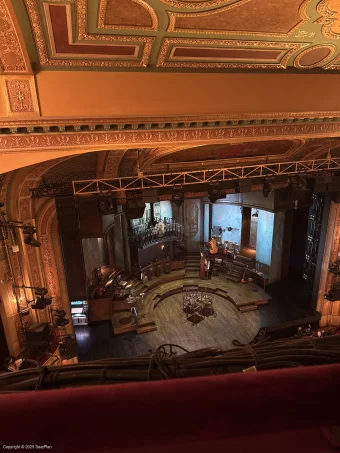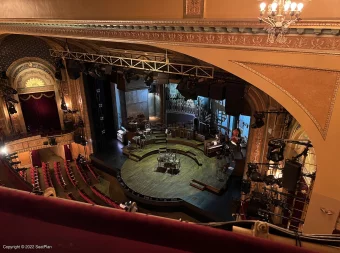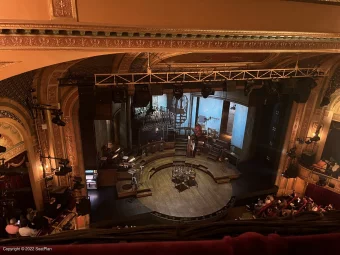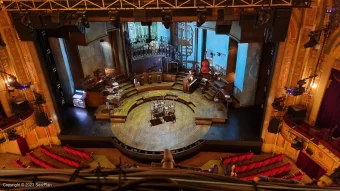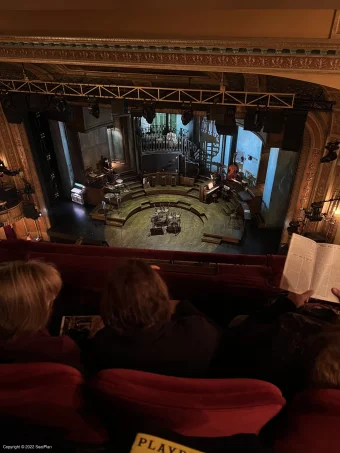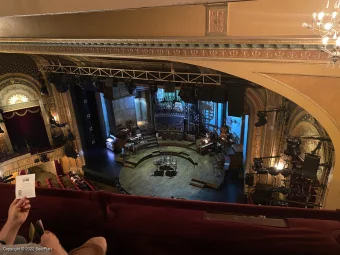42 Balcony Photos
SeatPlan members have added 42 Balcony view from seat photos to help you book the best Hadestown Broadway tickets. Help us get a photo from every seat - add your photos.
Balcony Guide
The Balcony is the smallest section of seating in the Walter Kerr Theatre, and is located two floors up from the Orchestra (52 steps). With just 74 seats across two rows, the Balcony features a Left and Right with an aisle dividing the two.
Views from the Balcony tend to be below average for the theater. Due to the height, patrons may feel a bit distant and find that parts of the bottom of the stage are cut off by lighting rigs and safety railings. Some seats such as B18 also have thin support pillars located in their sight line.
The section’s stairs and rake are steep, and the angle may mean patrons have to lean forward to see action happening towards the front of the stage. Despite this, some theatergoers may find that, if they can work around the obstructions, the overhead view of the stage and cheap ticket price is worth compromising for.
Seats in the Balcony are partial view, and prices are the cheapest of the entire venue to reflect this.
Left Balcony
The Left Balcony comprises two rows of odd-numbered seating starting at 1 on the inside and extending to 41 on the outside edge. Row B is shorter, with seat B1 situated behind A11, and B31 behind B41. Legroom at this height is cramped, with just a few options to sit on aisles for better space. The angle of the section also means that patrons will find objects including lighting rigs attached to the outside of the Balcony and the ceiling in their sightlines. Sitting in row A gives patrons the opportunity to move around obstructions more easily than row B, and the angle of the Balcony can afford a fair bird’s-eye view of the stage below for the price.
Right Balcony
The Right Balcony is very similar in size and view to the Left, with even-numbered seating from 2-42 in row A and 2-32 in row B. Seat B2 is located behind seat A12. Legroom is similarly limited on this side, with the best space on the four aisle seats. The curve of the ceiling, lighting rigs and support poles (such as near seat B18) can all cause obstructions to the view, and patrons are better served in row A where they are more freely able to maneuver around these. Sitting in row B may mean a significant part of the bottom of the stage is cut off, partly by patrons in row A leaning forward. The steep rake and small auditorium help to offset the restricted sightlines and give an overhead view of the stage. These seats rest in the lowest price range for the theater.
SeatPlan’s best views of the stage
The Walter Kerr Theatre Balcony’s small size means there is not much difference between the front and back rows, although seats towards the center in row A avoid patrons in front blocking the view.
Best legroom seats
The eight aisle seats offer more legroom than elsewhere on the Balcony, which is quite steep and tight between rows.
Tips
- Lighting rigs can stick out in front, disrupting your sight line
- The rake is very steep and may feel uncomfortable for patrons who dislike heights
- A thin support pole affects sight lines from seat B18
- Restrooms are located between the Mezzanine and Orchestra; patrons may want to use them before the performance to avoid the interval rush
- Patrons wanting to experience Broadway on a budget may be able to compromise on view for a lower pric
Pricing
Seats in the Balcony are all around the same price, which is also the cheapest price bracket in the Walter Kerr Theatre.
Bars
A bar is located one level down (15 steps), at the rear of the Mezzanine. Only drinks with covered tops can be taken back to the seating area.
Toilets
Restrooms for both men and women are located between the Mezzanine and Orchestra, approximately 33 steps down. Queues can get long during the interval and will probably be filled by audience members from the lower sections first.

